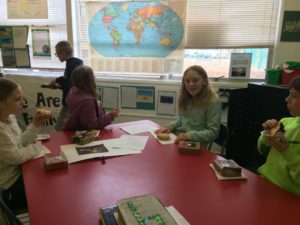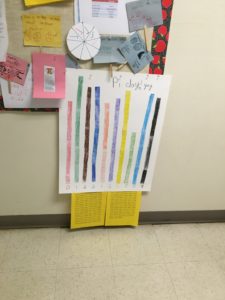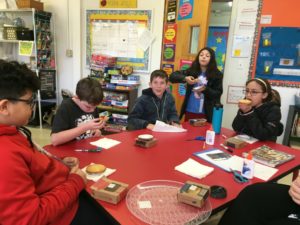by Macky & Veronica | Mar 29, 2019 | Preschool
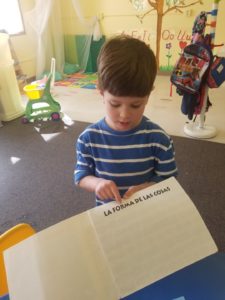
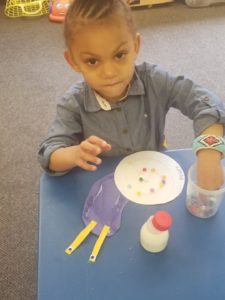
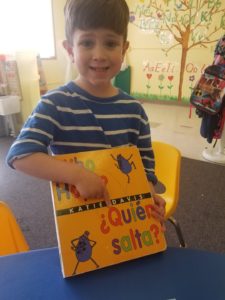
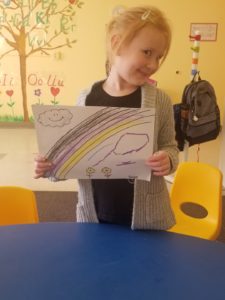 This week we worked with and talked about the spring season. The children learned that spring is a very beautiful time of the year, when the rain falls, the flowers sprout, and many animals are born like pigs, lambs and deer. Some animals come out of their lairs like bears. They also learned that it is very fun to play in the water and splash with their rain boots and rain coat and, if the weather is nice enough, it’s possible to fly the kites.
This week we worked with and talked about the spring season. The children learned that spring is a very beautiful time of the year, when the rain falls, the flowers sprout, and many animals are born like pigs, lambs and deer. Some animals come out of their lairs like bears. They also learned that it is very fun to play in the water and splash with their rain boots and rain coat and, if the weather is nice enough, it’s possible to fly the kites.
The children had a lot of fun doing projects such as bees where the children developed fine motricity and the development of attention skills. We used yellow, black and white colors. They also did activities like a bright sun with strips of tissue forming a rainbow. To finish the last day of the week(Friday) the children made a nice snail that amused the children at the time of its elaboration, this in order to show their ability to count when sticking colors, following the line in the shape of a snail. This was a great activity for their fine motor skills.
El libro de la semana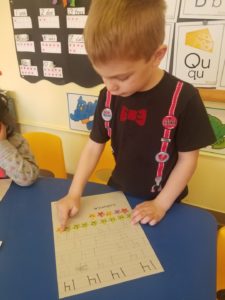
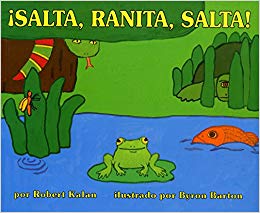

Thank you and have an excellent spring break!
by Ivary & Paola | Mar 22, 2019 | In The Loop
La Lectura
This week we spent most of our time on science. We were very efficient with the use of our time and were able to cover our Literacy fundamental routines. These included:
Essential Question: How do people uncover what they have in common?
Genre studies: Fiction
Spelling: Consonant Clusters
Word Work: Homophones and Homographs
Grammar: Understand the use of possessive pronouns.
Ciencias
What are the basic genetic mechanisms that determine the traits expressed by individuals in a population?
This part of the investigation/ discussion introduced students to the structures and mechanisms of heredity. They learned the structures involved: cell, nucleus, chromosome, allele, and gene. They were introduced to the functional relationships that determine genetic processes: genotype, phenotype, dominant allele, and recessive allele. Students practiced decoding the genotype of a larkey to discover what traits it has. They read an article that included a brief history of the discoveries leading to the understanding of genetics and a review of the structures and mechanisms involved.
• The individuals in every population vary from one another in their traits.
• Heredity is the passing of information from one generation to the next.
• Chromosomes are structures that contain hereditary information and transfer it to the next generation; they occur in nearly identical pairs in the nucleus of every cell.
• Genes are the basic units of heredity carried by chromosomes.
Mathematics
This week we learned about circles!
- We learned how to find the area of a circle
- We learned how to find the length of arcs
- We learned how to find the perimeter of a circle, also called the circumference
- We learned how to find the area and circumference of different figures
(Written by:Christian)
History & Geography
This week we learned about the Romantic revolution and the Neoclassical revolution.
- We learned the differences between neoclassical and romantic revolucion.
- We learned about the arts, and composers of that time
- We read a poem by William Wordsworth and drew bits of the poem.
(Written by:Maddie)
English Writing & Spelling
In writing this week we continued working on our argumentative writing piece.
- Worked on CUPS which stands for capitalization, usage, punctuation, and spelling.
- We completed our peer reflection
In Greek and Latin Roots this week we
- Learned the roots tri, quad, quint, quar, and penta which means three, five and four.
- Finished writing new words in our bingo board and completed our definitions
(Written by: Sophia)
by Sarah Segall | Mar 22, 2019 | In The Loop
History & Geography
- Understand the further actions of Parliament and the colonial responses to these actions.
- Explain what happened at the Boston Massacre.
- Identify Sam Adams and explain his role in forming the Committees of Correspondence.
- Describe the colonists´ attitude toward Britain after the Boston Massacre.
- Explain how the Committees of Correspondence formed and what their purpose was.
- Understand the events that resulted in the Boston Tea Party.
- Describe what happened at the Boston Tea Party.
- Explain what the Intolerable Acts were.
- Describe the colonists´ reactions to the Intolerable Acts.
- Identify the First Continental Congress and explain why it met.
- Understand the outcome of the First Continental Congress.
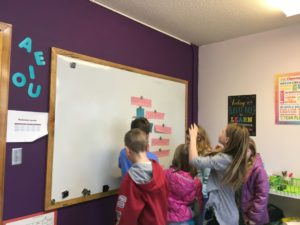
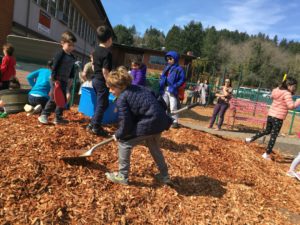
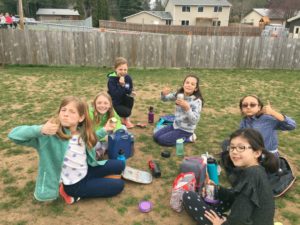 Mathematics w/Laura
Mathematics w/Laura
Week of March 18, 2019 – March 22, 2019
Chapter 11 Squares and Rectangles
- Squares and Rectangles (sides and angles)
- Properties of Squares and Rectangles
- Alert: Chapter 11 Assessment on Thursday, March 28th
Puzzles available for extra credit and Friday (Math) Bingo
Remember: MATH …. It’s everywhere
La lectura
This week we have been doing a lot of reading in our science studies! Our language arts objectives were:
- Correctly identify and form the different types and classes of sentences.
- Determine and eliminate excess words from sentences.
- Ask questions to clarify cereal box requirements
Reminder: Cereal Box book reports are due 3/29. Students who are leaving town early need to turn it in before they leave.
Spelling test: Friday, March 29th.
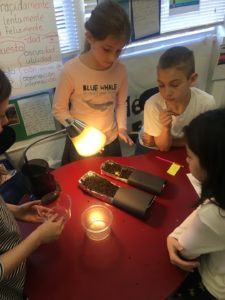
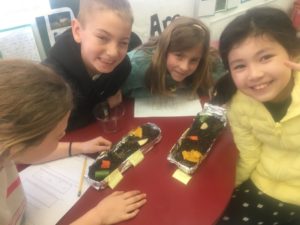
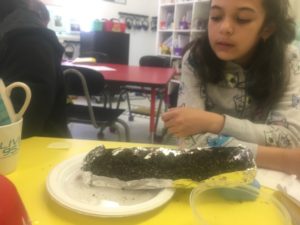
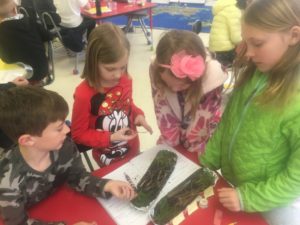
Ciencias
This week we tested how our isopods and beetles reacted to light. We conducted an experiment covering part of their runways and then recorded their locations after 10 minutes and again after an hour.
Students designed their own animal investigations using the runways. We went out and collected additional materials for this. Some environmental factors that could be tested in the runways are:
- Things to hide under at one end of the runway.
- Put leaves, grass, or twigs at one end of the erunway to find out food or shelter preference.
- Temperature (hot side vs. cold side)
by Jill & Sarah | Mar 22, 2019 | In The Loop
History & Geography
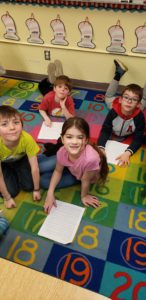
Practicing our reader’s theater.
This week we finished our unit on the War of 1812. We read about Old Ironside, the Treaty of Ghent, the Battle of New Orleans, and the outcomes of the war. On Thursday the class had fun doing a reader’s theater about the key people in this unit. We had our assessment on Friday.
Our weekly objectives were to:
• Understand the meaning of the “Star Spangled Banner” by analyzing the language used by Key, and why it is our national anthem.
• Identify significant individuals and groups in the War of 1812
• Explain why the Battle of New Orleans was fought after the signing of the Treaty of Ghent
Science
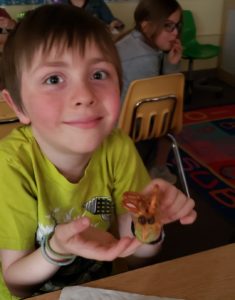 We took our domain assessment this week and the class did terrific; we really know our bugs and insects! On Thursday, as a reward, we watched “Miniscule” and had some insect snacks. Friday we began our last science domain, Simple Machines. To kick off this new unit we learned a Simple Machines song and did a lesson on “work” comparing different ways to make butter and the amount of work involved.
We took our domain assessment this week and the class did terrific; we really know our bugs and insects! On Thursday, as a reward, we watched “Miniscule” and had some insect snacks. Friday we began our last science domain, Simple Machines. To kick off this new unit we learned a Simple Machines song and did a lesson on “work” comparing different ways to make butter and the amount of work involved.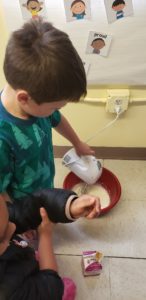
Our weekly objectives were to: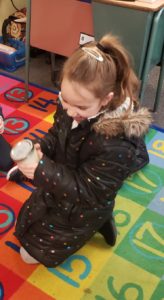
• review and assess what we’ve learned in our insect domain
• develop an understanding of quantities associated with energy, movement, and change
• identify that machines help us work and name different types of machines and how they work
English Spelling and Writing
In our journals we used the idiom of the week ” She has ants in her pants ” . The class got their new spelling sort and took their practice test on Friday. Our Word Wall words were: slow, those, that’s, thank.
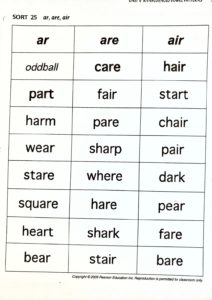
Blue spelling sort
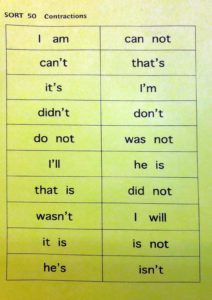
Green spelling sort
La lectura
This week we created our Animal Reports.
Our weekly objectives were to:
- read and highlight important information from an article about our animal
- answer comprehension questions about the article
- write a report about your animal using the information you learned
- High Frequency Words for the week: niño niña mejor tu reír quién pero (quiz on Monday!)
Las matemáticas
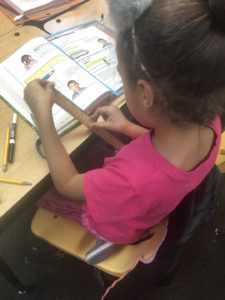
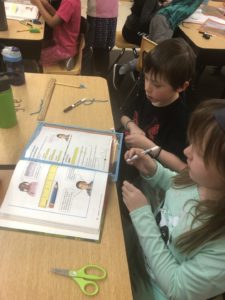 This week we began learning about customary units of measurement. Our weekly objectives were to:
This week we began learning about customary units of measurement. Our weekly objectives were to:
- compare lengths
- find the difference in lengths of objects
- use a ruler to estimate and measure length in feet and inches
- draw parts of lines given the length
by Sarah Segall | Mar 22, 2019 | In The Loop
La lectura y Las matemáticas
We are having a blast with our hands-on measurement activities. The students also continue to work on their number identification and counting skills. They are starting to see the patterns to count by 2’s!
They also are working on their estimation skills! Avi will bring in the estimation jar for next week.
They are becoming more and more confident in their Spanish sentences with the word of the day. They are doing a great job dictating to themselves and are becoming more confident in their journal writing.
Students should be reading their books every day to help with their fluency!
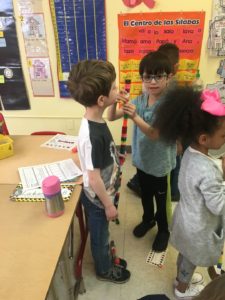
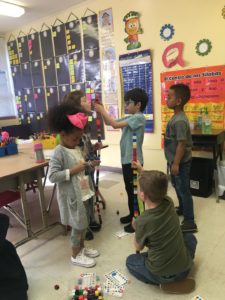
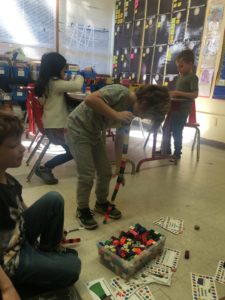
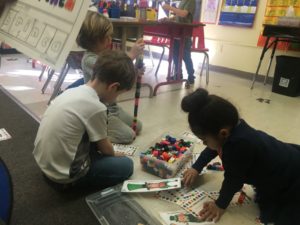
History & Geography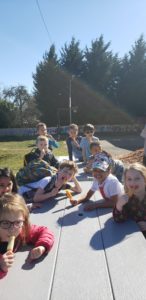
This week in Colonial trades people, we learned about the blacksmiths. We read a story, called “The Little Gray Pony”, that illustrated how trades were sometimes dependent on one another. In Daily Geography we worked on relative and absolute location.
Our weekly objectives were to:
• describe the blacksmith’s trade
• identify, and associate with the blacksmith trade, the tools and material used.
• retell the story using literary language (plot, setting, etc.) and temporal vocabulary (first, next, finally).
• use and recognize location vocabulary, answer questions about locations.
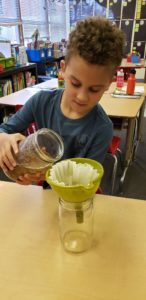 Science
Science
This week in our Taking Care of the Earth domain we continued to learn about pollution. We read about air and water pollution. We finished our polluted water experiment on Thursday.
Our weekly objectives were to:
• understand that air pollution from one location can make even the air that it’s far away in other places around the world dirty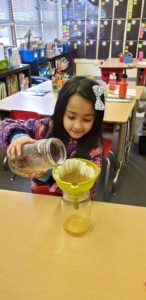
• identify sources of air pollution, including cars and electricity produced by coal-fired power plants
• explain how to reduce air pollution by conserving natural resources • identify sources of water pollution including factory waste and garbage
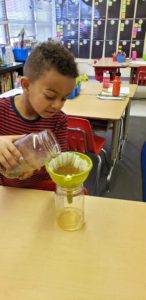
• explain that a water treatment plant can remove unhealthy chemicals and pollutants from water to make it usable again
by Macky & Veronica | Mar 22, 2019 | Preschool
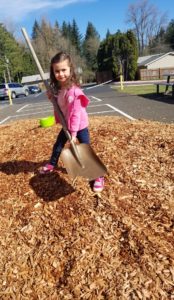
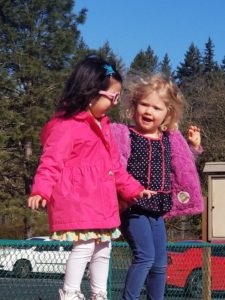
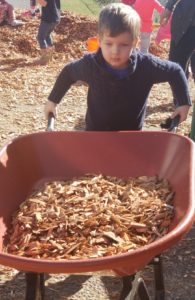
The preschoolers helped the entire school with the wood chip project!
This week we continued working with the unit “The Media”. They learned during this unit why the media is important to society. Through communication we can inform ourselves and educate ourselves and connect with others. Therefore, we finished this week learning about the computer as a means of communication. The children learned that the computer is an instrument that helps us to learn many things, to communicate and entertain us. We also talked about the use of our senses; the sense of sight to observe, the sense of touch and the sense of hearing.
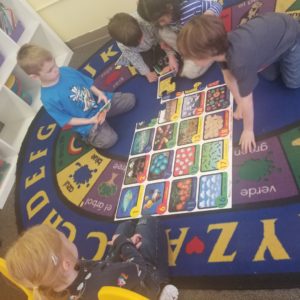
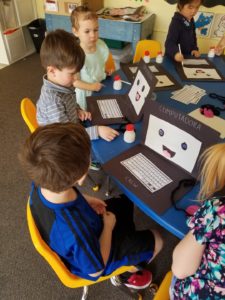
Finally, to end the week we did a review of the means of communication (mail, radio, television, telephone, newspaper, magazine and computer) The children a blast creating paper computers and doing a media recognition activity. The children did an excellent job.
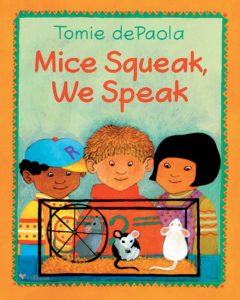 Our book of focus this week were Mice Squeak, We Speak by Tommie DePaolo.
Our book of focus this week were Mice Squeak, We Speak by Tommie DePaolo.
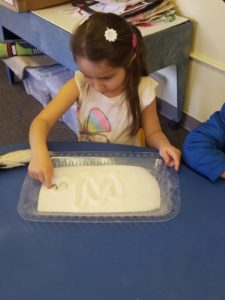
We practice correct letter formation: top down!

Gracias, que tengas un excelente fin de semana.
by Ivary & Paola | Mar 15, 2019 | In The Loop
La Lectura
• Determine or clarify the meaning of unknown and multiple-meaning words and phrases.
• Demonstrate understanding of figurative language, word relationships, and nuances in word meanings.
• Determine a central idea of a text and how it is conveyed through particular details; provide a summary of the text distinct from personal opinions or judgments.
• Trace and evaluate the argument and specific claims in a text, distinguishing claims that are supported by reasons and evidence from claims that are not.
• Describe how a particular story’s or drama’s plot unfolds in a series of episodes as well as how the characters respond or change as the plot moves toward a resolution.
• Engage and orient the reader by establishing a context and introducing a narrator and/or characters; organize an event sequence that unfolds naturally and logically.
• Understand the use of possessive pronouns.
• Spell word with x.
Dear families, in an attempt to help students with their Spanish reading at home (I have noticed students have been lacking Spanish reading practice!), and reinforce some of the concepts seen in class, students will be bringing Spanish reading homework packets every Monday. It is their responsibility to turn in their homework on Friday. Please make sure that your child has a consistent daily reading routine in Spanish of at least 15 minutes every night. I always remind the importance of practice, in order to achieve advanced levels of accuracy in their second language. Thank you for your continued support!
Ciencias
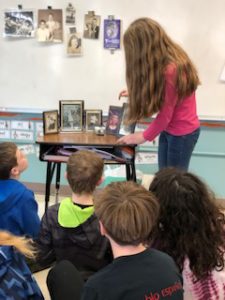 During this investigation, students investigate the underlying mechanisms of change in population. They learn how organisms inherit traits from their parents and how dominant and recessive alleles interact to produce traits in a population. Some of the big concepts we will see during this investigation are:
During this investigation, students investigate the underlying mechanisms of change in population. They learn how organisms inherit traits from their parents and how dominant and recessive alleles interact to produce traits in a population. Some of the big concepts we will see during this investigation are:
• Heredity is the passing of information from one generation to the next.
• Chromosomes are structures that contain hereditary information and transfer it to the next generation; they occur in nearly identical pairs in the nucleus of every cell.
• Genes are the basic units of heredity carried by chromosomes
This week, students looked at four of their features to determine what trait they have: little fingers straight or bent, earlobes attached or not, hairline forms a widow’s peak or not, and tongue can curl or not. They determined the distribution of the four traits in the class. Students then studied a population of larkeys, a make-believe animal, to analyze their traits.
Students are encouraged to bring some family photographs to share with the class!
Mathematics
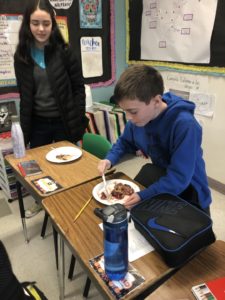
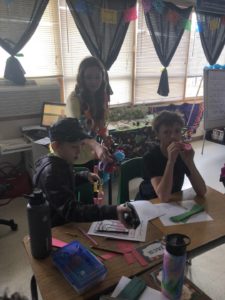 This week we learned about pi!
This week we learned about pi!
- We listened to 100 digits of pi song
- We also figured out how to use it in fraction and decimal form to calculate circumference and area.
- The equation for area is πr2
- The equation for circumference is πd
(Written by:Evan)
History & Geography
This week we learned about Napoleon and his role in the French Revolution.
- We talked about how Napoleon Bonaparte changed France after the Reign of Terror.
- We discussed his successes in France and his downfall
- We read journal entries by a Napoleonic soldier.
English Writing & Spelling
In writing this week we continued working on our argumentative writing piece.
- We added titles to our argumentative writing.
- We exchanged words in our writing.
In Greek and Latin Roots this week we
- Finished our greek and latin roots packet (Bi, du, amphi/ambi) which means two, or both.
(Written by: Tamra)
by Sarah Segall | Mar 15, 2019 | In The Loop
History & Geography
Our weekly objectives were to:
- Understand the events of the French and Indian War.
- Identify the provisions of the peace treaty between the British and the French.
- Understand the implications of the war´s outcome for Britain and the American colonies.
- Understand the colonial policies Britain made as a result of the French and Indian War, including the Proclamation of 1763.
- Understand the effects of these policies on the American colonies.
- Understand the Stamp Act.
- Explain how the colonists organized themselves to protest the Stamp Act.
Mathematics w/Laura
Week of March 11, 2019 – March 15, 2019
The week of π Day (Pi Day) — irrationally good!!!
- Each student made his/her slice of our pie (Pi),
as we displayed them in the hall.
- Teams of students measured the circumferences and diameters
of 16 different sized circles to find the value of pi.
- Each student made a wearable piece of pi art!
- Teams of students plotted the frequency of the
digits 0 through 9 in the first 200+ digits of pi, poster in the hall.
- Of course, we sang The Pi Song and ate pie!
Puzzles available for extra credit and Friday (Math) Bingo
Remember: MATH …. It’s everywhere
La lectura
This week we began our new unit: Medicine from long ago and medicine today. This unit really shows the scientific process and highlights the importance of good record keeping! We can use these great examples to help us with our science experiments.
We have now started a verb race activity in which the students will have 4 minutes to conjugate a verb correctly 30 times, using the subjects and the tense given. This is just drill practice but reinforces our verb study and will help them in their writing.
There was no new spelling list this week.
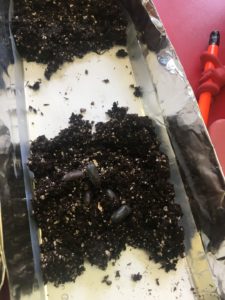
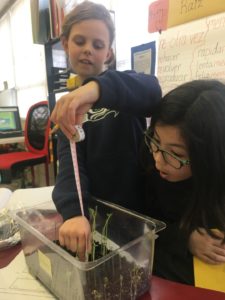
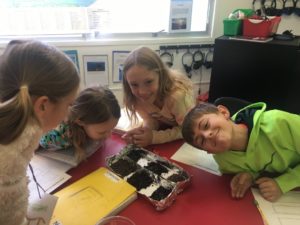
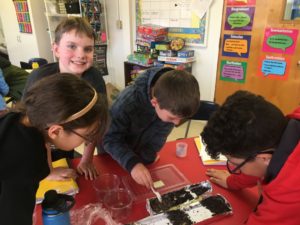
Ciencias
This week we continued observing our terrariums, making adjustments to the environment and recording all changes. We also began our second Environments investigation: Bugs and Beetles. In this investigation students will:
- Investigate how moisture affects isopod and beetle behavior.
- Organize and analyze data from animal investigations.
- Determine an organism´s environmental preferences for various environmental factors (moisture this week).
- Use scientific thinking processes to conduct investigations and build explanations: observing, communicating, comparing, organizing, and relating.
by Jill & Sarah | Mar 15, 2019 | In The Loop
History & Geography
This week we read more about America at War in 1812, including naval battles against the British and failed attempts to invade Canada. We read the “Star-Spangled Banner” and analyzed Key’s poem in regards to what he was experiencing during the battle at Fort McHenry.
Our weekly objectives were to:
• Understand the story of Francis Scott Key and the “Star Spangled Banner”
• Identify American Naval victories and defeats
• Explain why the Battle of New Orleans was fought after the signing of the Treaty of Ghent
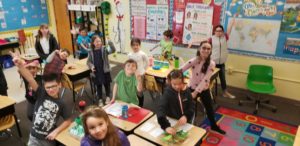 Science
Science
We worked hard this week putting our speeches together for our insect reports. On Thursday the class did a great job presenting their models and doing their speeches. Everyone should be proud of themselves for their efforts. We will take our Insect domain assessment next Monday.
Our weekly objectives were to:
• Write a speech based on the research gathered from the insect report.
• Edit and revise the speech
• Practice reading the speech with a partner
• Present the speech to the class and describe how your model was made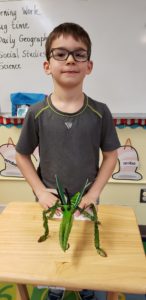
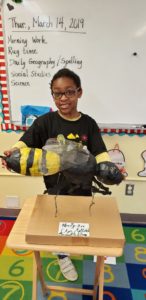
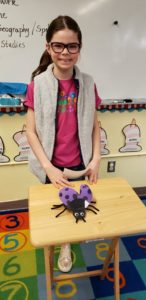
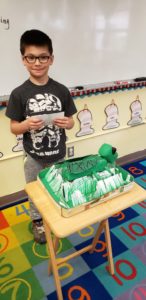
Spelling and Writing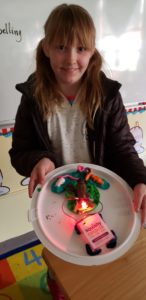
In our journals we used the idiom of the week ” he is a barrel of laughs ” . The class worked on two spelling assignments and took their final spelling test on Friday. Our Word Wall words were: shook, sometimes, short.
La lectura
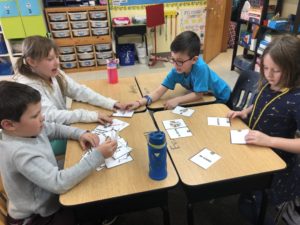
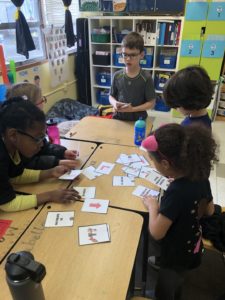 This week we read De donde saco sus manchas la gallina de guinea.
This week we read De donde saco sus manchas la gallina de guinea.
Our weekly objectives were to:
- we focused on making connections and predictions during our first read
- during our second read we worked on drawing conclusions throughout the story
- learn a poem about prepositional words then we played a prepositional word matching game
Students also brought home instructions for the Spanish Animal Reports. If you have any questions please let me know!
Las matemáticas
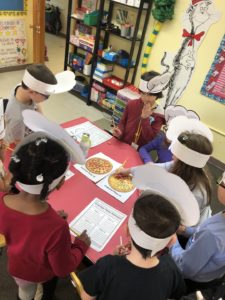
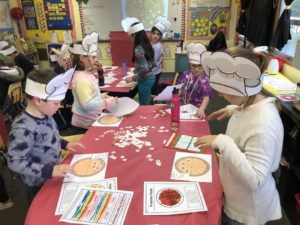 This week we learned about fractions!
This week we learned about fractions!
Our weekly objectives were to:
- identify fractions that name more than one equal part of a whole
- use models to add and subtract fractions
- add and subtract like fractions
- review our objectives by working in Ms.Ivary´s pizza kitchen!
by Sarah Segall | Mar 15, 2019 | In The Loop
La lectura
This week we began our new Rojo, blanco y negro language arts unit. We are learning about patriotism and what makes a good citizen. We talk about what makes a good citizen within our classroom and within our school, working together and listening to each other are key!
Students also impressed me with their use of Spanish this week! Someone flipped the switch and they all were using great sentences and asking and answering questions in Spanish.
In writing we moved beyond everyone copying a prompt from the board to them ‘dictating’ their own sentence. They had to form their own sentence and then stretch it out while writing (so they could hear all the sounds from the words they wanted to write). They did an amazing job! I was so proud of this milestone!!
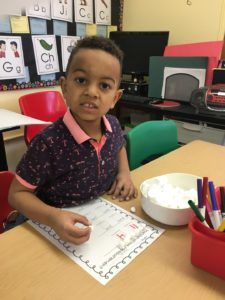
Measuring with two sizes of marshmallows.
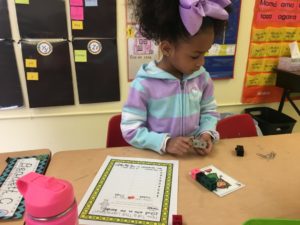
Using cubes and big paper clips to measure leprechauns.
Las matemáticas
We had so much fun exploring our measurement unit this week! We also started our estimation jar (always a favorite!). Each week a student will bring the estimation jar home of Friday and should pick like items (same size legos, same size cars, same size dolls, same size gold fish, etc). Students will estimate how many items they think are in the jar. Then we will fill a small clear cup with those items, count how many fit in there, and then make a second estimation. Please do NOT have your child count how many items they put in! Also, there are clear instructions that will come home with the estimation jar but DO NOT put it in the dishwasher!!
Major was the first one to take the jar home. We can’t wait to make our estimations on Monday!!
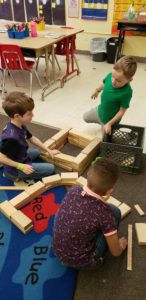
Bricklayers
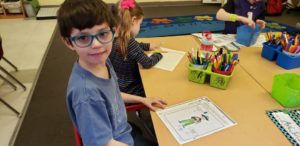 History & Geography
History & Geography
This week in Colonial trades people, we learned about the house builders: masons, bricklayers, and carpenters. We talked about the meaning of the sayings “Measure twice, cut once” and “Better safe than sorry”. On Thursday the class acted out some of the trades we have recently read about. This week we began working on daily geography skills, we will be learning how to read and create maps, answer questions, analyze graphic information, and make connections to ourselves. Look for our finished practice work in the take home folders.
Our weekly objectives were to:
• describe the bricklayer, mason, and carpenter in a colonial town
• identify, and associate with the appropriate trade, the tools used by the people we have learned about
Science
This week in our Taking Care of the Earth domain we learned about pollution. We discussed the different kinds of pollution and how it affects our world. On Thursday we did a demonstration of air pollution. We read a trade book about taking care of the Earth.
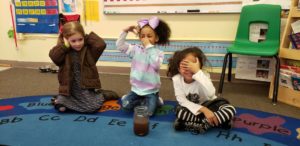
Water pollution is not good!
Our weekly objectives were to:
• understand that land, air, and water all suffer from different types of pollution, and all types of pollution are caused by human activities.
• understand that if people are careful and creative, they can help reduce pollution



 This week we worked with and talked about the spring season. The children learned that spring is a very beautiful time of the year, when the rain falls, the flowers sprout, and many animals are born like pigs, lambs and deer. Some animals come out of their lairs like bears. They also learned that it is very fun to play in the water and splash with their rain boots and rain coat and, if the weather is nice enough, it’s possible to fly the kites.
This week we worked with and talked about the spring season. The children learned that spring is a very beautiful time of the year, when the rain falls, the flowers sprout, and many animals are born like pigs, lambs and deer. Some animals come out of their lairs like bears. They also learned that it is very fun to play in the water and splash with their rain boots and rain coat and, if the weather is nice enough, it’s possible to fly the kites.




































